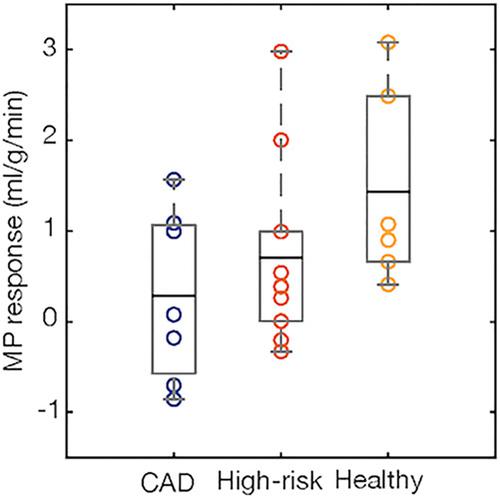当前位置:
X-MOL 学术
›
NMR Biomed.
›
论文详情
Our official English website, www.x-mol.net, welcomes your feedback! (Note: you will need to create a separate account there.)
Feasibility of coronary endothelial function assessment using arterial spin labeled CMR.
NMR in Biomedicine ( IF 2.9 ) Pub Date : 2019-12-04 , DOI: 10.1002/nbm.4183 Ahsan Javed 1 , Andrew Yoon 2 , Steven Cen 3 , Krishna S Nayak 1 , Parveen Garg 2
NMR in Biomedicine ( IF 2.9 ) Pub Date : 2019-12-04 , DOI: 10.1002/nbm.4183 Ahsan Javed 1 , Andrew Yoon 2 , Steven Cen 3 , Krishna S Nayak 1 , Parveen Garg 2
Affiliation

|
Coronary endothelial dysfunction (CED) is an independent predictor of cardiovascular disease, but its assessment has been limited to invasive coronary angiography. Myocardial perfusion imaging using arterial spin labeled (ASL) cardiac magnetic resonance (CMR) may be an effective non-invasive alternative for detection of CED. Thirty-four patients were recruited: 10 healthy volunteers, 13 at high-risk for coronary artery disease (CAD), and 11 with established CAD. ASL-CMR was performed continuously in a single mid-short axis slice during rest, stress, and recovery. Stress was induced with sustained isometric handgrip exercise, an endothelial dependent stressor. Myocardial perfusion (MP) during rest, peak stress, and recovery were calculated and compared. After excluding subjects unable to complete the protocol or who exhibited poor data quality, 6 healthy, 10 high-risk, and 7 CAD patients were included in the analysis. Average MP (ml/g/min) was 1.31 ± 1.23, 1.61 ± 1.12, and 1.40 ± 0.97 at rest, and 1.64 ± 1.49, 2.31 ± 1.61, and 2.84 ± 1.77 during stress, for the CAD, high-risk and healthy group, respectively. The average MP response (MPstress - MPrest , ml/g/min) was 0.32 ± 1.93, 0.69 ± 1.34, and 1.44 ± 1.46 for CAD, high-risk and healthy group, respectively. MP during handgrip stress was significantly lower for both the CAD (p = 0.0005) and high-risk groups (p = 0.05) compared to the healthy volunteers. In only the healthy subjects, MP was significantly higher in stress compared to rest (p = 0.0002). Participants with CAD had significantly lower MP response compared to healthy volunteers, as detected by ASL-CMR. These findings support the feasibility of ASL-CMR for non-invasive assessment of CED.
中文翻译:

使用动脉旋转标记的CMR评估冠状动脉内皮功能的可行性。
冠状动脉内皮功能障碍(CED)是心血管疾病的独立预测因子,但其评估仅限于侵入性冠状动脉造影。使用动脉自旋标记(ASL)心脏磁共振(CMR)进行的心肌灌注成像可能是检测CED的有效非侵入性替代方法。招募了34名患者:10名健康志愿者,13名冠心病(CAD)高危患者和11名已建立CAD的患者。在休息,压力和恢复期间,在单个中短轴切片中连续进行ASL-CMR。持续等轴测手柄运动(一种内皮依赖性应激源)可诱发压力。计算并比较静息,峰值压力和恢复期间的心肌灌注(MP)。在排除无法完成实验方案或数据质量较差的受试者之后,分析中包括6例健康,10例高风险和7例CAD患者。对于CAD,高风险和健康人群,静止时的平均MP(ml / g / min)为1.31±1.23、1.61±1.12和1.40±0.97,而在压力下为1.64±1.49、2.31±1.61和2.84±1.77组。CAD,高风险和健康组的平均MP响应(MPstress-MPrest,ml / g / min)分别为0.32±1.93、0.69±1.34和1.44±1.46。与健康志愿者相比,CAD(p = 0.0005)和高风险组(p = 0.05)的手握压力下的MP均显着降低。仅在健康受试者中,MP的压力显着高于休息(p = 0.0002)。通过ASL-CMR检测,与健康志愿者相比,患有CAD的参与者的MP反应显着降低。
更新日期:2020-01-21
中文翻译:

使用动脉旋转标记的CMR评估冠状动脉内皮功能的可行性。
冠状动脉内皮功能障碍(CED)是心血管疾病的独立预测因子,但其评估仅限于侵入性冠状动脉造影。使用动脉自旋标记(ASL)心脏磁共振(CMR)进行的心肌灌注成像可能是检测CED的有效非侵入性替代方法。招募了34名患者:10名健康志愿者,13名冠心病(CAD)高危患者和11名已建立CAD的患者。在休息,压力和恢复期间,在单个中短轴切片中连续进行ASL-CMR。持续等轴测手柄运动(一种内皮依赖性应激源)可诱发压力。计算并比较静息,峰值压力和恢复期间的心肌灌注(MP)。在排除无法完成实验方案或数据质量较差的受试者之后,分析中包括6例健康,10例高风险和7例CAD患者。对于CAD,高风险和健康人群,静止时的平均MP(ml / g / min)为1.31±1.23、1.61±1.12和1.40±0.97,而在压力下为1.64±1.49、2.31±1.61和2.84±1.77组。CAD,高风险和健康组的平均MP响应(MPstress-MPrest,ml / g / min)分别为0.32±1.93、0.69±1.34和1.44±1.46。与健康志愿者相比,CAD(p = 0.0005)和高风险组(p = 0.05)的手握压力下的MP均显着降低。仅在健康受试者中,MP的压力显着高于休息(p = 0.0002)。通过ASL-CMR检测,与健康志愿者相比,患有CAD的参与者的MP反应显着降低。


























 京公网安备 11010802027423号
京公网安备 11010802027423号